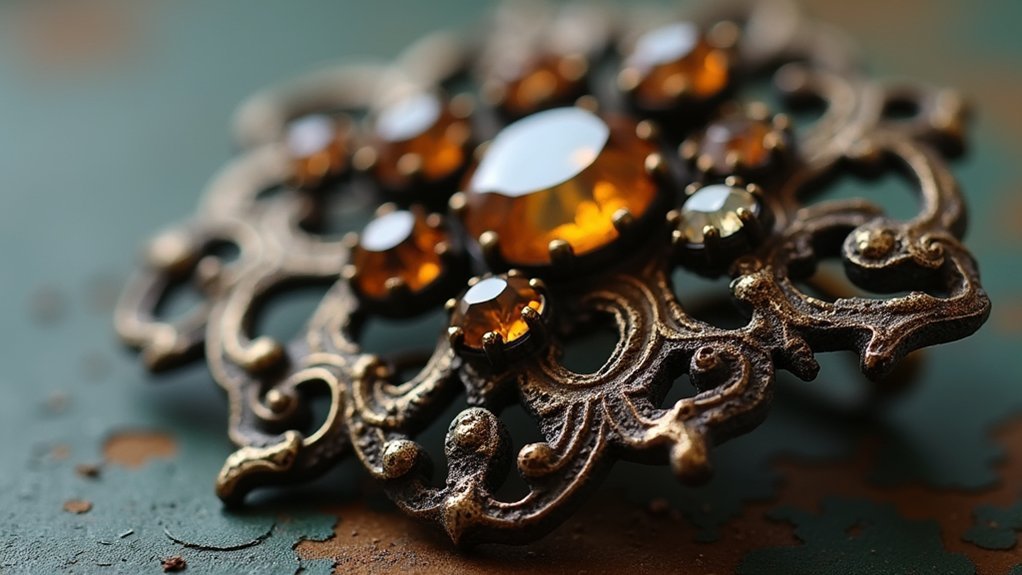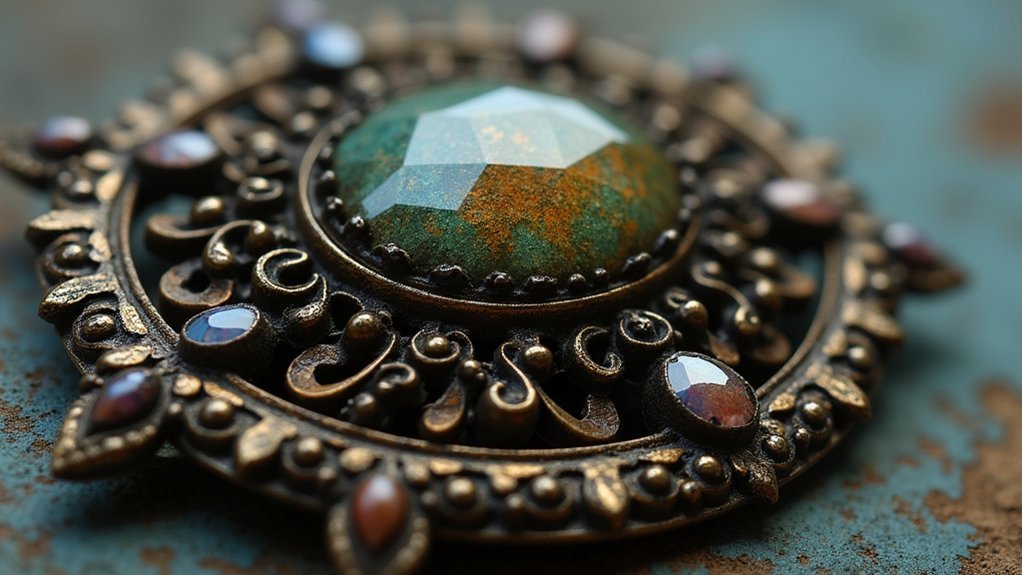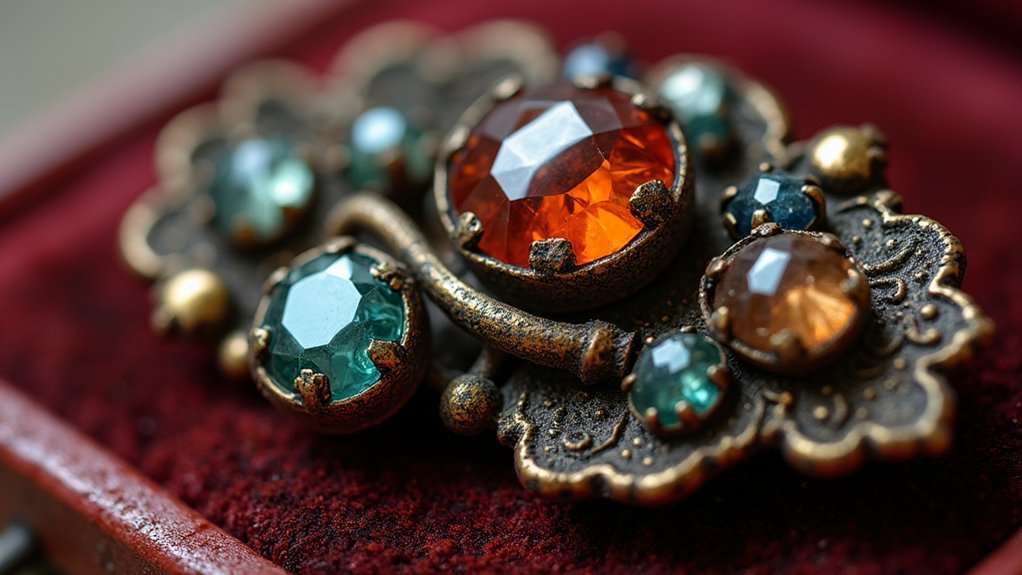Your antique brooch pins stop working due to metal fatigue from decades of repeated clasp manipulation, which creates microscopic stress fractures that eventually cause complete failure. Age-related corrosion and oxidation weaken the metal structure, while broken pin stems, worn clasp mechanisms, and loose joint connections compromise functionality. Missing safety catches and bent pin stems also render brooches unwearable. Understanding these common issues will help you identify problems early and take proper preventive measures.
Metal Fatigue and Age-Related Deterioration

When you examine antique brooch pins closely, you’ll often discover that metal fatigue has compromised their structural integrity through decades of repeated opening and closing. Each time you’ve manipulated the clasp mechanism, microscopic stress fractures have developed within the metal’s crystalline structure.
These tiny cracks gradually expand over time, eventually causing visible breaks or complete failure of the pin’s functionality.
Age-related deterioration compounds this problem considerably. You’ll notice that older brooches frequently show signs of corrosion, tarnishing, and surface oxidation that weaken the metal beyond its original specifications.
The base metals and lower-quality alloys commonly used in vintage jewelry simply can’t withstand prolonged exposure to environmental elements like their modern counterparts, making metal fatigue an inevitable consequence of time.
Broken or Missing Pin Components
When you’re dealing with antique brooches that won’t stay secured to your clothing, you’re likely facing issues with broken or missing pin components.
You’ll often find that the pin stem has snapped off completely, the clasp mechanism has worn down from decades of use, or the tiny hinge components that allow the pin to open and close have failed.
These mechanical failures don’t just affect functionality—they can make your treasured piece completely unwearable until you address the specific damaged components.
Missing Pin Stems
One of the most frustrating problems you’ll encounter with antique brooches is discovering that the pin stem has broken off or gone missing entirely. Without this critical component, your beautiful brooch becomes nothing more than decorative jewelry you can’t actually wear or secure to clothing.
The pin stem often disappears due to metal fatigue from decades of use. Constant stress from pinning and unpinning weakens the attachment point where it connects to the brooch’s main body.
Corrosion also plays a significant role, gradually eating away at the metal until the connection fails completely.
When you’re examining vintage pieces, check carefully for any signs of a missing pin stem, as replacement can be costly and may affect the brooch’s authenticity and value.
Worn Clasp Mechanisms
Beyond missing pin stems, worn clasp mechanisms present another significant challenge for collectors of antique brooches.
These deteriorating components can transform your treasured jewelry into unreliable pieces that risk falling off and getting lost.
Worn clasp mechanisms affect your brooch’s security in several ways:
- C-clasps lose their grip – Traditional C-clasps lack locking mechanisms, making them prone to slippage as metal fatigue sets in over decades of use.
- Safety clasps break down – Delicate vintage safety mechanisms often crack or jam, leaving you with non-functional backup security.
- Material weakness develops – Aging metals become brittle and lose their spring tension, causing clasps to fail under normal wear.
You’ll need regular inspection and professional maintenance to keep these worn clasp mechanisms functioning properly.
Broken Hinge Components
Something as small as a broken hinge component can render your entire antique brooch unwearable. These delicate mechanisms face constant wear and tear, especially in vintage pieces with less secure designs.
When broken hinge components fail, you’ll experience pin slippage or complete detachment from the clasp. Antique brooches often lack modern locking mechanisms, relying instead on traditional C-clasps that don’t provide adequate security.
The fragile materials used in vintage jewelry can’t withstand regular movement and tension, making hinge failure inevitable over time. You’ll notice missing pieces or damaged components that prevent proper pin function.
Professional restoration becomes necessary to preserve your brooch’s integrity and functionality, requiring skilled jeweler intervention to repair or replace these vital mechanical elements.
Clasp Mechanism Failures
Although antique brooches possess timeless elegance, their clasp mechanisms often become the weakest link in an otherwise enduring piece of jewelry. Years of wear gradually loosen C-clasps and safety clasps, making your brooch prone to detaching from clothing unexpectedly. The delicate materials and aged components can’t withstand regular stress like modern alternatives.
You’ll notice clasp mechanisms fail more frequently when certain conditions align:
- Fabric compatibility issues – Your brooch slips easily on silk compared to wool’s grip.
- Missing locking mechanisms – Vintage designs lack secure fastening features found in contemporary pieces.
- Movement and adjustment stress – Regular repositioning weakens already compromised components.
Regular inspection prevents unexpected failures. Check your clasp’s tension and examine for visible wear before each use to maintain your antique brooch’s functionality.
Corrosion and Oxidation Damage

When moisture and oxygen penetrate your antique brooch’s metal surface, they trigger chemical reactions that permanently alter its composition and appearance. This corrosion process transforms once-lustrous metals into dull, tarnished surfaces that compromise both function and beauty.
| Metal Type | Corrosion Signs | Vulnerability Level |
|---|---|---|
| Brass | Green patina, pitting | High |
| Copper | Blue-green oxidation | Very High |
| Silver | Black tarnishing | Moderate |
| Steel | Red-brown rust | High |
| Gold-plated | Base metal exposure | High |
Your brooch faces accelerated damage when exposed to acidic substances like perfumes or body oils. Non-precious metals prove especially susceptible due to their reactive chemical compositions. You’ll notice color changes, texture deterioration, and structural weakening as oxidation progresses. Proper storage in dry environments and regular cleaning greatly slow this destructive process.
Loose or Worn Joint Connections
Beyond surface damage from oxidation, your antique brooch’s mechanical components face their own deterioration challenges. Years of use and metal aging create loose or worn joint connections that compromise your brooch’s functionality.
These weakened joints decrease friction and stability, making your treasured piece unreliable during wear.
The deterioration affects several key areas:
Age weakens critical brooch components including clasps, vintage joints, and pin connections, compromising both security and functionality over time.
- C-clasp mechanisms become less secure over time, increasing detachment risks when you’re moving around.
- Delicate vintage joints can’t handle modern movement patterns, leading to frequent malfunctions during regular use.
- Pin connections may fail completely without proper maintenance, potentially causing you to lose your valuable brooch entirely.
Regular handling exacerbates these issues, making periodic inspection of your brooch’s mechanical integrity essential for preserving its functionality.
Damaged or Lost Safety Catches

You’ll often find that your antique brooch’s safety catch has either stopped working properly or gone missing entirely over the decades.
These catch mechanism failures typically occur when the spring tension weakens or the metal components wear down from repeated use.
When safety components are missing, you’re left with a beautiful but risky piece that can easily fall off and become lost forever.
Catch Mechanism Failures
Although antique brooch pins possess timeless beauty, their delicate catch mechanisms pose significant risks that can result in permanent loss of your treasured piece.
Catch mechanism failures occur when the intricate components that secure your brooch deteriorate from age and wear.
These vintage fastening systems weren’t designed for today’s active lifestyle.
Here’s what causes them to fail:
- C-clasps and safety catches weaken from decades of metal fatigue, making them unreliable for securing your brooch properly.
- Daily friction from clothing adjustments and physical contact gradually wears down the delicate springs and hinges within the mechanism.
- Lack of regular inspection means you won’t notice loose components or hairline cracks until your brooch unexpectedly detaches and disappears.
Missing Safety Components
Even when the primary catch mechanism remains functional, missing safety components create an equally dangerous vulnerability.
You’ll find that antique brooches often lose their safety catches over decades of wear, leaving you with only the primary pin closure. These missing safety components dramatically increase your risk of losing valuable pieces during normal activities.
Vintage C-clasps and open-hinged designs are particularly susceptible to damage or complete loss.
When you’re missing these vital backup mechanisms, your brooch relies entirely on a single point of failure. The delicate locking mechanisms weren’t designed for modern movement patterns, making replacement essential.
You should inspect safety components regularly and seek professional repair when they’re compromised.
Without proper safety catches, even functional primary mechanisms can’t guarantee secure attachment.
Bent or Misaligned Pin Stems
When antique brooches endure decades or even centuries of use, their delicate pin stems often develop bends or become misaligned, creating frustrating attachment issues that can render these treasured pieces nearly unwearable.
A bent pin stem won’t properly align with the clasp mechanism, making fastening difficult or impossible. You’ll notice the brooch won’t sit flat against your clothing or keeps coming loose during wear. Regular movement and pressure worsen existing bends, progressively compromising functionality.
A misaligned pin stem creates attachment problems, causing your brooch to sit poorly and detach unexpectedly during wear.
Signs your pin stem needs attention:
- Visible curvature – You can see the pin stem isn’t straight when viewed from the side.
- Poor clasp engagement – The pin doesn’t slide smoothly into the safety catch mechanism.
- Frequent detachment – Your brooch falls off or loosens repeatedly during normal wear.
Jewelers recommend periodic inspections and professional straightening or replacement when necessary.
Material Incompatibility Issues

As antique brooches age, the metals and alloys used in their construction often deteriorate at different rates, creating structural weaknesses that compromise the pin mechanism’s reliability.
You’ll encounter material incompatibility when different metals in your brooch expand and contract at varying rates due to temperature changes or aging. This causes joints to loosen and connections to fail.
The soldering techniques from decades past weren’t designed to handle modern material incompatibility issues. Base metals corrode differently than precious metals, creating galvanic reactions that weaken bond points.
You’ll notice plated components separating from their underlying metals as adhesion fails over time. These mismatched materials create stress points where your brooch’s pin mechanism becomes vulnerable, ultimately leading to complete functional failure despite the piece’s decorative appearance remaining intact.
Frequently Asked Questions
What Is a Pin Stop on a Brooch?
A pin stop’s a small device on your brooch that prevents the pin from slipping out of the clasp. You’ll find it secures the pin in place, keeping your brooch safely attached to your clothing.
How to Keep Brooch Pins From Falling Off?
You can secure brooch pins by adding rubber earring backs as stoppers, upgrading to locking closures, reinforcing thin fabrics with interfacing, using double-pin techniques for heavy pieces, or trying magnetic converters.
How to Replace Pin on Brooch?
You’ll need 20-gauge jewelry wire to replace your brooch pin. Create a loop using round nose pliers, insert it into the pin holder, and secure with flat nose pliers for stability.
What Are the Different Types of Brooch Pin Closures?
You’ll find three main brooch pin closure types: C-clasps, which are traditional but less secure; safety clasps with hinged locking mechanisms; and barrel clasps that screw closed for reliable hold.
In Summary
You’ll find that antique brooch pins stop working due to decades of wear and tear affecting their delicate mechanisms. Metal fatigue weakens components, corrosion damages surfaces, and clasps lose their grip over time. You’re dealing with bent stems, broken safety catches, and loose joints that’ve simply worn out. Don’t expect these vintage pieces to function like new jewelry—they’ve earned their battle scars through years of faithful service and need careful restoration.





Leave a Reply